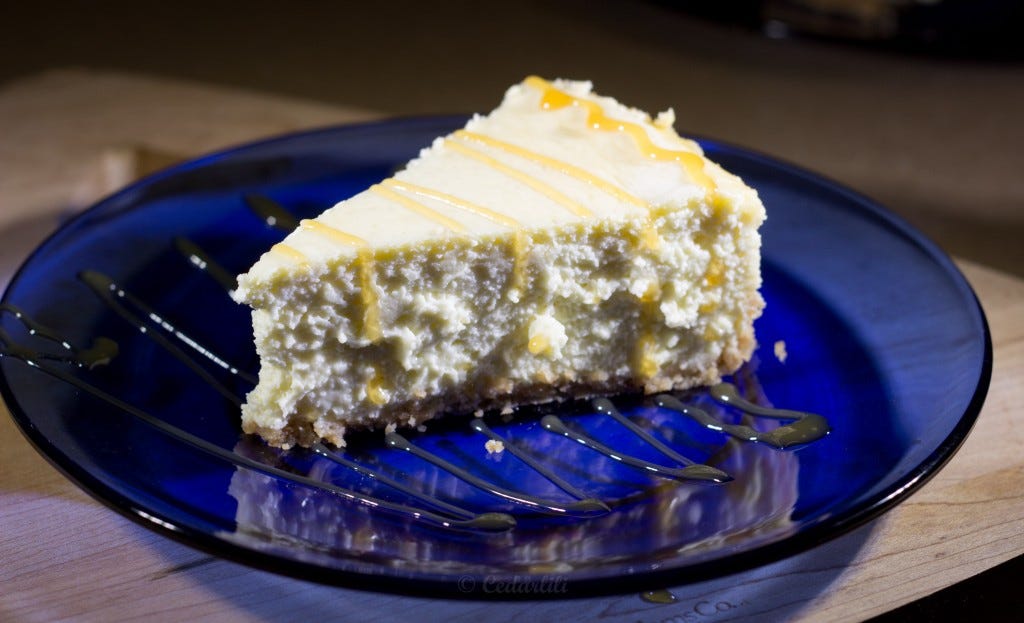Cheesecake
Cheesecake, like so many other things, is more a state of mind than a simple recipe. The variations on it are nearly infinite, and even the 'base' of the recipe can be changed up. I looked at bunches of recipes online, and finally pulled out a cookbook to give myself a starting point.
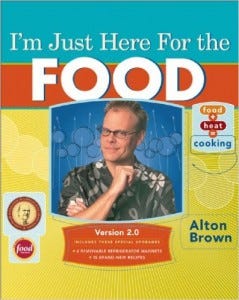
I really love Alton Brown's cookbooks. Like the show that brought him into the public eye, I'm Just Here for the Food and the companion I'm Just Here for More Food are full of techniques and science more than step-by-step recipes. If you want to learn how to be a better cook, you can't go far wrong with just these two books. The cheesecake recipe I was looking for is found in More Food, since that book covers baking.
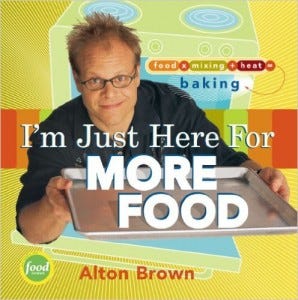
I was making cheesecake because I had bought some cream cheese and wanted to use it up before it went off. Fortunately, this recipe will let you do that. Although you may have to buy more to make up the amount, as I had to do. I didn't stick to the recipe (when do I ever?) completely, though. Because, well, I got busy and forgot something. I didn't realize what I'd done until it was far too late. But all was well, the cheesecake was delicious.
Serendipity Cheesecake
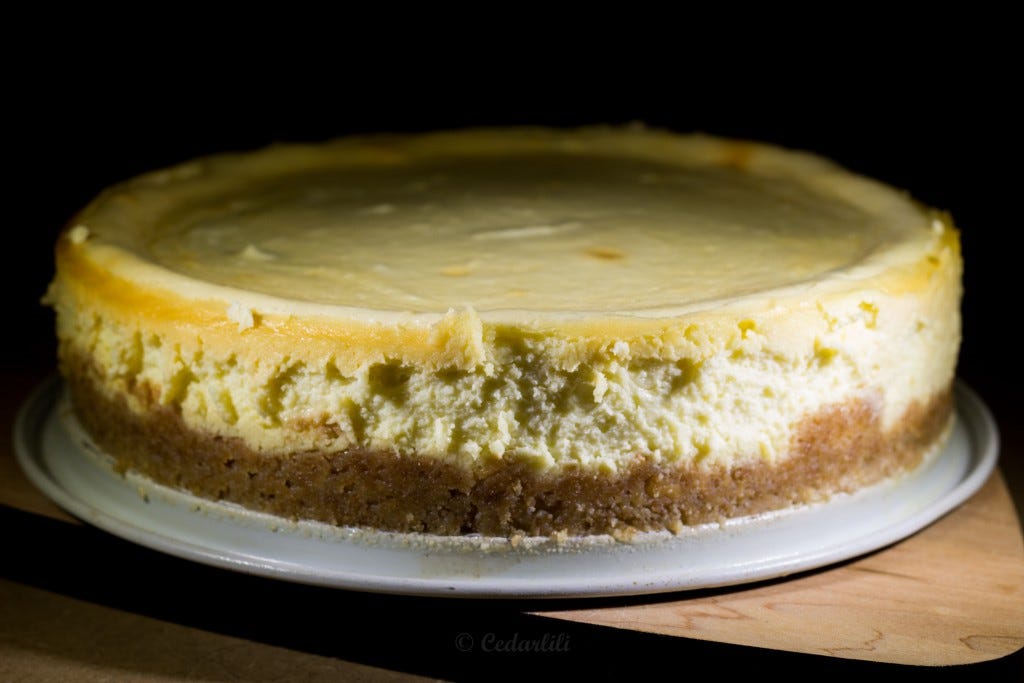
The cake is cheese
4 oz vanilla wafers
4 oz butter
24 oz cream cheese
1/2 cup sugar
3 egg yolks
1 tbsp vanilla extract
5 oz sweetened condensed milk
8 oz sour cream
Gather all your ingredients and tools. Set the oven to 300 F.
In the food processor with the blade attachment inserted, chop the 'nilla wafers up into small crumbs. Slowly add pieces of the butter until it is fully incorporated into the crumbs. Don't add sugar. You don't need it, really. Press this mixture evenly into the bottom of your pan - I used a 9" springform, but you can use a regular deep cake pan just as well. Just don't use a shallow pan. Trust me on this. The crumb crust should be even across the bottom and climb up the sides just a little. Put this in the oven and bake it for 10 minutes, then set in the fridge to cool off.
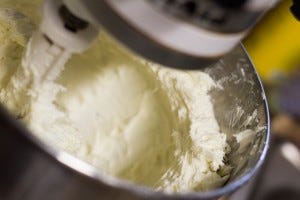
Cream cheese and sugar, beat until smooth.
Take the cream cheese (three blocks if you're buying the 8 oz bricks) and place it in a stand mixer bowl with the sugar. Set the mixer to medium speed and let it go to work. You'll want to stop it a couple of times and scrape the cheese mix back down the walls, but this process can keep going while you're on the rest of the prep.
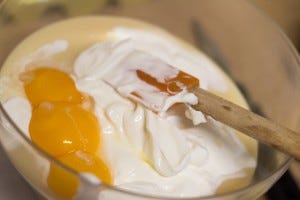
I used my weigh bowl to combine everything. Handy.
Weigh out and combine the sour cream, condensed milk (the rest of the tin works really well in strong black tea, the First Reader learned how to drink it this way when he was hanging out with British military types while he was a young GI. He happily made himself tea while I was making the cheesecake), vanilla, and egg yolks. Reserve the egg whites carefully and set them aside. I'll have a bonus recipe later today that uses them up. Whisk this mixture together. Scrape the cheese mix back down in the bowl and make sure it's smooth and creamy. If it's ready, slowly pour the egg mixture into the bowl while the batter blade is on low or med-low. You don't want to accelerate the blade during this process!
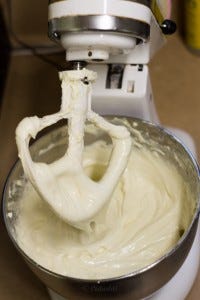
See? No lumps and fluffy.
Once it is all in the bowl, you can slowly turn up the speed and again, just let it go. Scrape the sides into the bowl with a rubber spat if you need to. You want this to get super creamy and fluffy.
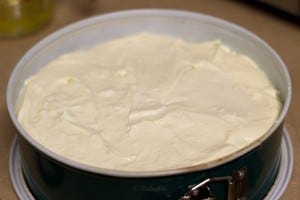
see the level of the batter? It will rise during baking. This is why you don't want a shallow pan.
Pull the crust out of the oven and get the kettle of tea water back up to a boil. Make sure you have a roasting pan or baking sheet large enough to set the springform pan into (I only have one, it turns out. Well, ok, I have two but the full sheet pan is overkill, and Rule 37 doesn't apply in baking). Stop the mixer if the batter looks smooth, and carefully dump it into the springform pan. Smooth the top out a bit.
Open the oven and carefully put about a quart of boiling water into the baking sheet or roaster. Set the springform in this, gently, and slowly put them on the racks (adjusted to allow max space above them, I think I had mine on the second notch up). Close the oven and set the timer for 80 minutes. Leave it alone.
Now, if this were an ETWYRT post, I'd talk about grabbing a good book and some of that workingman's tea the First Reader made while you waited. But it's not, so I sat at the computer and wrote about 2000 words on Tanager's Fledgling, the best production I've had in ages. By the end of the night I'd done 4200 words and was ecstatic.
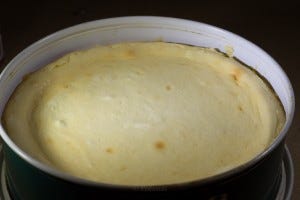
As it cools, the cheesecake will subside. This is ok.
When the timer goes off, take a peek at your creation. If the top is mostly firm, and just slightly golden-brown, it's ready to come out. Not ready to eat. No, that takes hours of cooling while the First Readers asks 'is it ready to cut?' and you cultivate patience like a garden.
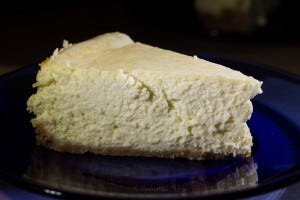
Fluffy cheesecake! This is not a dense version at all.
When it is finally cool enough to risk cutting into it without the slices falling to bits, cut slim slivers and note how light, airy, and delicate this cheesecake is. Realize that the original recipe called for three egg yolks AND two whole eggs. Take a bit. Realize that serendipitously, this version is delicious as it is and didn't need those old eggs, anyway. Slowly eat the rest of the slice and with monumental self-discipline, refrain from a second slice.
The next morning, have some for breakfast. Why not? It's cheese, and eggs, and milk (sort of). Fry up some bacon and you'll have a rounded meal. Cheesecake also freezes well, so you can save it and not eat it all up at once.
Oh! and toppings. Don't forget toppings. We had ours with a drizzle of caramel sauce, but I plan to cook down some blackberries with just a dab of sugar and run them through the food mill to break them down and remove most of the seeds. That will be delicious poured over a slice. Maybe for breakfast.
